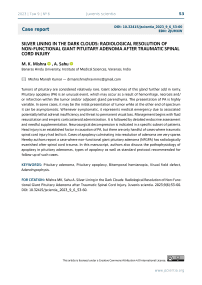Silver lining in the dark clouds: radiological resolution of non-functional giant pituitary adenoma after traumatic spinal cord injury
Автор: Mishra M.K., Sahu A.
Журнал: Juvenis scientia @jscientia
Рубрика: Клинические случаи
Статья в выпуске: 6 т.9, 2023 года.
Бесплатный доступ
Tumors of pituitary are considered relatively rare. Giant adenomas of this gland further add in rarity. Pituitary apoplexy (PA) is an unusual event, which may occur as a result of hemorrhage, necrosis and/or infarction within the tumor and/or adjacent gland parenchyma. The presentation of PA is highly variable. In some cases, it may be the initial presentation of tumor while at the other end of spectrum it can be asymptomatic. Whenever symptomatic, it represents medical emergency due to associated potentially lethal adrenal insufficiency and threat to permanent visual loss. Management begins with fluid resuscitation and empiric corticosteroid administration. It is followed by detailed endocrine assessment and needful supplementation. Neurosurgical decompression is indicated in a specific subset of patients. Head injury is an established factor in causation of PA, but there are only handful of cases where traumatic spinal cord injury had led to it. Cases of apoplexy culminating into resolution of adenoma are very sparse. Hereby authors report a case where non-functional giant pituitary adenoma (NFGPA) has radiologically evanished after spinal cord trauma. In this manuscript, authors also discuss the pathophysiology of apoplexy in pituitary adenomas, types of apoplexy as well as standard protocol recommended for follow-up of such cases.
Pituitary adenoma, pituitary apoplexy, bitemporal hemianopia, visual field defect, adenohypophysis
Короткий адрес: https://sciup.org/14129119
IDR: 14129119 | DOI: 10.32415/jscientia_2023_9_6_53-60
Список литературы Silver lining in the dark clouds: radiological resolution of non-functional giant pituitary adenoma after traumatic spinal cord injury
- Russ S, Anastasopoulou C, Shafiq I. Pituitary Adenoma. In: StatPearls. Treasure Island (FL): StatPearls Publishing; 2021.
- Muthukumar N. Pituitary Apoplexy: A Comprehensive Review. Neurol India. 2020;68(Supplement):S72-S78. DOI: 10.4103/0028-3886.287669
- Biagetti B, Simò R. Pituitary Apoplexy: Risk Factors and Underlying Molecular Mechanisms.Int J Mol Sci. 2022;23(15):8721. DOI: 10.3390/ijms23158721 EDN: AKHIBH
- Puglisi V, Morini E, Biasini F, et al. Neurological Presentation of Giant Pituitary Tumour Apoplexy: Case Report and Literature Review of a Rare but Life-Threatening Condition. J Clin Med. 2022;11(6):1581. DOI: 10.3390/jcm11061581 EDN: AREATO
- Sibal L, Ball SG, Connolly V, et al. Pituitary apoplexy: a review of clinical presentation, management and outcome in 45 cases. Pituitary. 2004;7(3):157-163. DOI: 10.1007/s11102-005-1050-3 EDN: RHIPQK
- Pal A, Capatina C, Tenreiro AP, et al. Pituitary apoplexy in non-functioning pituitary adenomas: long term follow up is important because of significant numbers of tumour recurrences. Clin Endocrinol (Oxf). 2011;75(4):501-504. DOI: 10.1111/j.1365-2265.2011.04068.x
- Billeci D, Marton E, Giordan E. Post-traumatic pituitary apoplexy: Case presentation and review of literature.Interdisciplinary Neurosurgery. 2017;7:4-8. DOI: 10.1016/j.inat.2016.10.006
- Joo C, Ha G, Jang Y. Pituitary apoplexy following lumbar fusion surgery in prone position: A case report. Medicine (Baltimore). 2018;97(19):e0676. DOI: 10.1097/MD.0000000000010676
- Lennon M, Seigne P, Cunningham AJ. Pituitary apoplexy after spinal anaesthesia. Br J Anaesth. 1998;81(4):616-618. DOI: 10.1093/bja/81.4.616 EDN: IMMAQL


